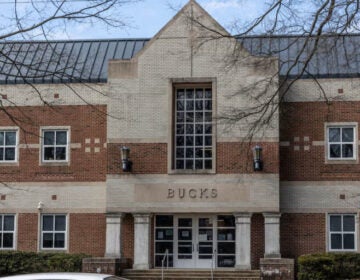Pa. bets on residency model to boost teacher prep programs

Pa. Governor Tom Wolf greets a 6th grade literacy class at Penn Treaty school. (Kimberly Paynter/WHYY)
With Pennsylvania licensing fewer and fewer teachers, the state recently announced it will send $2 million in federal aid to eight colleges and universities in hopes of boosting their teacher prep pipelines.
Its method of choice?
Teacher residency programs.
Through the federal government’s Title II program, Pennsylvania can dole out money to boost teacher and principal training and recruiting. The state’s plan under the new federal education law calls for $2 million of the state’s Title II dollars to be devoted to year-long teacher and principal residency programs.
Commonly compared to programs used to train doctors, teacher residencies typically emphasize in-class experience over book learning. Teachers spend an academic year embedded in a school alongside a mentor teacher, and then receive extra mentorship after the school year ends. When a teacher leaves a residency program, he or she has often spent more time in a classroom and received more one-on-one coaching than someone in a more traditional teacher prep program.
Studies suggest teachers who graduate from residency-style prep programs are more likely to stay in the classroom. There’s also evidence that residency programs attract more applicants of color. That’s of particular concern in Pennsylvania, where minorities make up a third of student enrollment but just six percent of the teaching force.
It’s unclear, however, if teachers trained through these rigorous — and expensive — programs perform better than their classically trained peers. Some evidence suggests they fare worse initially, but catch up after a few years in the classroom.
Officials from Pennsylvania’s Department of Education hope the method can help reverse some alarming trends. The state granted certificates to just 4,412 new teachers in 2016-17, down from 15,247 certificates just seven years earlier. Since 1996, the number of students receiving undergraduate degrees in education has fallen 55 percent. This despite the fact that Pennsylvania has 114 educator preparation programs.
Among them is Drexel University’s School of Education, which under the leadership of Nancy Butler Songer has embraced residency-style programs and integrated them into many of its graduate programs.
“The underlying models behind all of our programs are similar in that we value this opportunity to have concrete experience, plus reflection, in an immersive way,” said Songer, whose school partners with the National Center for Teacher Residencies.
While students in traditional prep programs might do a semester of student teaching, residency programs differ in a few key ways. Like medical residents, teacher residents work in small practice groups and receive regular feedback from mentors. They also stay for a full academic year and receive follow-up mentorship.
“They see every aspect of the roles and responsibilities of the teacher,” said Sarah Ulrich, Drexel’s associate dean of teacher education and undergraduate affairs.
Another key distinction: typical student-teachers pay for courses, while teacher residents actually receive a small stipend.
That means it’s more expensive to educate a teacher resident than a typical teacher-in-training.
Proponents say the investment pays off because teacher residents are more likely to stay in the profession, thus abrogating the need to train a replacement teacher in the future.
But teacher residency programs are still fairly new, and researchers aren’t totally clear on the pros and cons.
“I think the question for teacher residency programs, over time, is will they be able to demonstrate that the benefits exceed those costs,” said Martin West, a professor at Harvard’s Graduate School of Education who studied a pioneering residency program in Boston.
At $710,275, Drexel received the largest share of federal dollars recently doled out by the state. Indiana University of Pennsylvania and Robert Morris University also received six-figure implementation/expansion grants.
Another five schools received smaller planning grants to help develop full year residency programs. Those schools are: Cabrini University, Lehigh University, Millersville University, Penn State University – Harrisburg, and the University of Pennsylvania.
WHYY is your source for fact-based, in-depth journalism and information. As a nonprofit organization, we rely on financial support from readers like you. Please give today.






